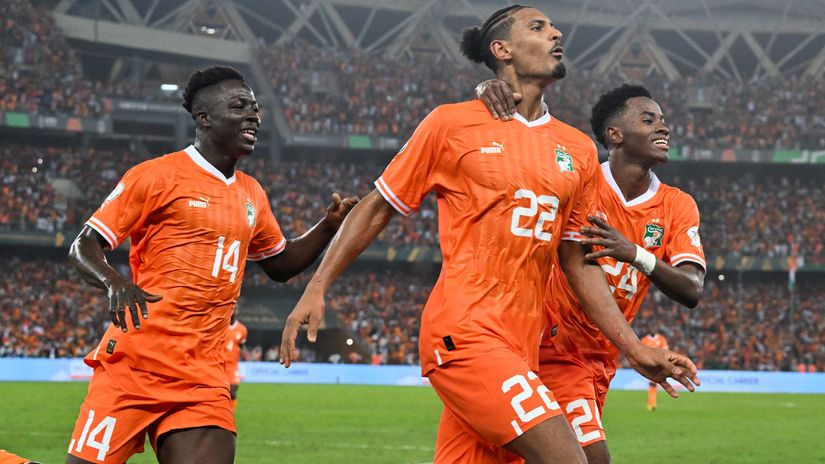The African Cup of Nations 2023 came to a close at the Olympic Stadium of Ebimpe when hosts Ivory Coast faced off against Nigeria on Sunday.The story in the build-up to this final was all about Cote d’Ivoire’s journey to the final of this tournament. The West African nation managed only one win in the group stages, and that was during the opening game of the tournament against Guinea Bissau when they secured a 2-0 victory.They then lost 1-0 to eventual finalists Nigeria in the second game, and a 4-0 defeat at the hands of Equatorial Guinea led to the sacking of then-manager Jean-Louis Gasset. However, the three points won in the group stage were enough to qualify them among the third-best losers.##NAJAVA_MECA_7863325##Assistant coach Emerse Fae took the team to the round of 16 where they faced the then-reigning champions Senegal. An 86th-minute equalizer from Frank Kessie led the match into penalties, where they won 5-4 and advanced to the quarterfinals. In the quarters, they were drawn against a youthful and exuberant Mali side. With Odilon Kossounou being sent off as early as the 43rd minute, the Elephants had to play with 10 men.A 90th-minute equalizer sent the game into extra time where they won 2-1. In the semis, they faced DR Congo. This time they did it comfortably with a 65th-minute Sebastian Haller goal sending them straight into the finals where they were going to face Nigeria. The script wasn’t about to change as they needed to come from a goal down to win 2-1 and be crowned the champions of Africa. So how did they manage to win against the Super Eagles? Let’s get into it.Coach Emerson Fae fielded a strong Cote d’Ivoire starting eleven in the shape of a 1-4-3-3. Yahia Fofana started in goal. Ghislain Konan and team captain Serge Aurier were the fullbacks. Evan Ndicka and Kossounou formed the center-back pairing. The midfield trio consisted of Jean Michael Seri, Frank Kessie, and Seko Fofana. Max Gradel and Simon Adingra played on either side of center forward Haller.His Nigerian counterpart Jose Peseiro fielded the same starting 11 that he had been fielding for the better part of the season. The team’s starting formation was a 1-3-4-3. Stanley Nwabali started in goal with Semi Ajayi, William Troost Ekong, and Calvin Bassey as the starting center backs. Ola Aina and Zaidu Sanusi were the wingbacks.Ethiopia advances in FIFA U-17 Women’s World Cup qualifiers, set up a crunch Kenya tieFrank Onyeka and Alex Iwobi started in the middle of the park. Samuel Chukwueze and Ademola Lookman played on either flank with Victor Osimhen leading the line.From the buildup, Ivory Coast were positioned in a 4-1-2-3 buildup structure with the two number 8s positioning themselves between the Nigerian defense and midfield lines. This shape was comfortable as Nigeria, who were defending in a 5-3-2 shape, were passive in their press. The front two of Nigeria’s defensive shape, Victor Osimhen and Ademola Lookman, allowed Cote d’Ivoire time and space to push forward.However, the Nigerian pressing structure was narrow, including the 5-man defensive line. This narrow shape meant that Ivory Coast couldn’t build up through the center of the field, and they were forced to play wide. This invitation to attack the wide zones was received well by the Elephants. Their wingers Adingra, and Gradel stayed wide, hugging the touchline. It was from these positions that they would be able to receive the excellent long-range passes from Ndicka and Kessie and look to take on the Nigerian wingbacks 1v1.To try and force some central build-up, Kessie would often drop deeper alongside Seri to form a double pivot and look to take the ball off the center backs; however, this movement did little to disrupt the disciplined Nigerian midblock, and therefore, they rarely executed it.Nigeria, on the other side, went for a 3-2 build-up structure. With them already having three center backs, there was no need for a lot of structural changes. The center backs spread wide just outside the box while the two midfielders formed a double pivot just ahead of them. The wingbacks pushed high up, almost like makeshift wingers, forming what resembled a 5-man attack together with the front three. To counter this, Ivory Coast defended in a 4-1-4-1. Haller as the center forward started the press, urging Nigeria to play to one side. He was outnumbered in a 3v1, and therefore he couldn’t press aggressively.AFCON 2023: Top performers fetedThe midfield 2, however, in the bank of 4 went man to man on the Nigerian double pivot. The wide players in the bank of 4 cut passing lanes to the Nigerian wingbacks. In defense, the Ivory Coast’s back four were close to each other. The narrow backline was to ensure no space for the pacy Nigerian attackers. All three strikers for the Super Eagles are effective when attacking space, and the Elephants weren’t going to allow them that chance.When the ball was played by the Nigerian center backs into the double pivot, Kessie and Fofana were ready to pounce. This led to a couple of turnovers that led to dangerous transitions in favor of the hosts. Cote d’Ivoire’s first goal was brought about by the occupation of their midfielders in between the lines and their wingers holding width. Seko Fofana playing in between the lines put pressure on the Nigerian midfield.Ndicka switches the ball out to the right to Gradel, the winger forced left wingback Sanusi out of the backline creating space for Kessie to attack. This chance led to a corner which was converted by Kessie, who was hanging unmarked at the back post. The second Ivory Coast goal came from their wingers holding width. After one failed attack, the ball is switched to Adingra who isolates Ola Aina in a 1v1. Adingra won the battle and made a lofted cross that was calmly slotted home by Haller.AFCON 2023: Mozzart Sport Kenya’s team of the tournament

